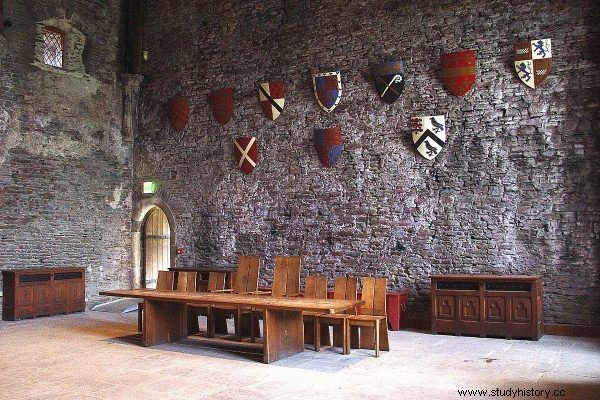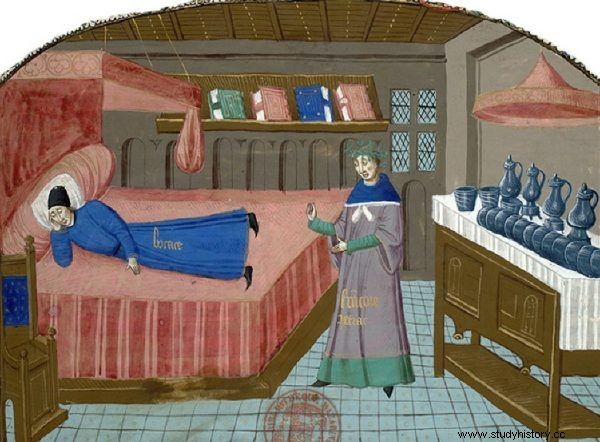Underfloor heating and running water. Dishes cooked in almond milk and seasoned with saffron. Perhaps, after all, your life in a medieval castle was not as barbaric as popular movies suggest? Do today's millionaires have anything to envy to the croesuses from a thousand years ago?
Medieval castles seen in films such as "Robin of Sherwood" or "The Cursed Kings" are terrifying. They are damp, cold, dark and, above all, dirty. The camera with the stubbornness of a maniac gives close-ups on bundles of rotten straw scattered across the stone floor, on uneaten, smelly bones scattered under the tables and on the ubiquitous rats that do not despise human flesh. There is no hint of romanticism in it, visible even in the paintings of 19th-century painters who portrayed the ruins of long-abandoned buildings. And yet the medieval castle was not barbaric at all!
1. Decorative hall - crowded and noisy
The hall played an important role in every seat of medieval nobles. It was there that the life of the castle was concentrated. This room was finished with special care. The floor was a carefully polished floor made of gypsum or lime mortar or covered with stone slabs. Animal skins or woolen carpets were placed on it. The fabrics were also hung behind the back of the stool on which the lord of the castle sat. The walls were decorated with geometric or figural paintings.

The modern reconstruction of the hall even does not fully reflect the magnificence of this room. Photo is from Caerphilly Castle, Wales.
It was by no means dark in the hall. During the day, light fell through the windows, and in the evening, many candles were lit in circular, crown-like candlesticks. The fire in the fireplace also lit the room.
It is here that crowded and noisy breakfasts and dinners were made. But meals are a separate topic. Even when you take into account the changing culinary tastes and technological possibilities that have separated our era since those times, medieval food surprises with fantasy.
2. Almond milk, anise and saffron
For example, they served chicken and rice paste cooked in almond milk, seasoned with sugar and anise. Or a meat sauce based on unripe grape juice, seasoned with wine vinegar, ginger, saffron, onion, cloves, cinnamon and mustard.
Various types of fish were very popular, especially in the lenten periods:from common trout to sturgeon, cetaceans and porpoises. The latter species, although to our knowledge belong to mammals, have even been called "royal fish". The English king, on the other hand, had a taste for lampreys. Frances and Joseph Gies cite his order from 1230 to the sheriff of Gloucester in the book "Life in a Medieval Castle":
As after tasting the lampreys all the fish already seem bland to the king and his mistress , the sheriff should obtain by purchasing or otherwise as many lampreys as he can in his ward. After putting them in butter and jelly, he should send them to the king.
The chef's technique was also full of fantasy. After all, there were no known pressure cookers, refrigerators, two-circuit stoves or food processors. However, other solutions were found. This is how the Giess describe the castle kitchen:
In the kitchen, the cook and his assistants turned meat (pork, mutton, poultry or game) on a grill and prepared stews and soups in huge cast iron pots hung over the fire on hooks and chains . Everything was designed in such a way that the boilers could be raised or lowered depending on the required temperature.

During medieval feasts, not only were sophisticated dishes served, but also the etiquette was taken care of. In this French miniature from the 15th century, we see a roasted peacock stepping onto the table.
3. Clean hands and nails
At the medieval feast, the atmosphere was also important. And this one was far from the drunkenness and orgies popularized by contemporary series. There was an etiquette:the dishes were served in the correct order, the man served the woman, the younger the elder.
Good upbringing required compliance with a number of rules. The attention was paid to the cleanliness of hands and nails, and to wiping the mouth with a handkerchief. It was forbidden to keep the elbows on the table or to mix the meat in the dish with salt. Appropriate topics for conversation were sought. The musicians also made the guests happy.

The latrine was built not only to protect the inhabitants of the castle from odors and provide them with quick access. Care was also taken that the dirt left the castle quickly. Here we see a paragraph in English Peveril.
4. Flush latrine
It is also untrue that the medieval man did not care about the dirt around him. Although the level of technology at that time did not allow for everything, efforts were made to provide the inhabitants of the castle with the greatest possible comfort, and thus also the possibility of taking care of their own hygiene.
The latrines were a big challenge for the builders. They were discreetly hidden in bay windows, covered with thin walls on narrow supports. They were made so that the excrement fell down, outside the castle - without contact with the wall. It also happened that rainwater from gutters or water from the kitchen rinsed the toilet shaft.
One of the orders of Henry III Plantagenet, King of England in the years 1216-1272, proves how important the issue of sanitary equipment was for the inhabitants of the castles. He ordered that a new toilet be built as soon as possible in his London residence. The old one, stressed the monarch, " is located in an unsuitable and inappropriate place, which makes it smell bad ". The ruler allocated a considerable sum of one hundred pounds for this purpose. Instead, he only demanded that the work be completed before he even got home.
5. Access to running water
Fresh water was also commonly available at the castles. There was usually a well inside the keep, i.e. the castle residential and defense tower. Harvest points were placed on each floor. Baths were taken in a wooden tub, covered with a tent or a canopy, often lined with delicate linen.
If the weather was fine, the toilets in the garden were refilled. In winter, the tub was placed next to the fireplace. The aforementioned Henry III, undoubtedly paying special attention to hygiene, even in London had… a separate bathroom with hot running water. It was taken from tanks filled with water heated in a special boiler.
6. Medieval underfloor heating
Some medieval castles used underfloor heating called hypocaustum (or hypocaustum). There was an empty space under the floor, into which hot air was fed from the furnace through a special channel. Wawel was insulated in this way already in the 11th century. The system was also used in castles in Malbork and Wleń.

Medieval bed - comfortable, comfortable and providing privacy. Miniature from "Cas des nobles hommes et femmes", ca. 1470-1480.
7. Sleep in down nappies
After the bath, you could go to sleep. The places intended for this were impressive, which is perfectly demonstrated by medieval painting. The beds appeared, for example, in the scenes of the Annunciation or the Dormition of the Blessed Virgin Mary. As reported by Frances and Joseph Gies, this piece of furniture usually had a heavy wooden frame and springs made of lines or strips of leather:
This included a down mattress, sheets, duvets, leather covers and pillows. These beds could have been taken apart and taken on a journey during the numerous trips the great lord made to his other castles and mansions. The bed was surrounded by linen curtains which were rolled up during the day and pulled down at night to ensure privacy and protection against drafts.
8. Privacy in silk and diamonds
The possibility of covering the bed was an expression of an emerging need for privacy. In the thirteenth century, it was already large enough that small rooms were designed to provide the feudal family with maximum discretion. In the distant future, they were to be transformed into the master's office and his wife's boudoir. For now, they have been a new expression of luxury.
When Władysław Jagiełło found out that Jadwiga Andegaweńska was expecting a child, overjoyed, he decided to upholster her private room with silk with precious stones sewn on it. The sane and pious queen, however, did not allow this gesture, fearing it would be a bad omen.
